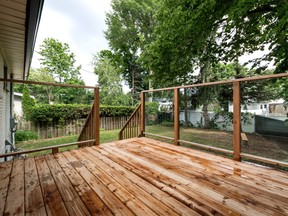
Reviews and recommendations are unbiased and products are independently selected. Postmedia may earn an affiliate commission from purchases made through links on this page.
Article content
Would you like your new deck, gazebo or other outdoor structure to last longer and require much less maintenance? Wood-free alternatives are becoming more common and better, and as you will see, these products offer easier life, less maintenance, and a longer lifespan.
Article content
Steel Deck Frames
The largest part of any deck is the supporting frame, and the posts, beams, and joists are still made of wood in most cases. The wood combines great strength, resistance to warping and reasonable price, but is prone to rot. Steel decking frames are the newest structural alternative to wood, and a handful of companies make various systems, each with their own design and fixing approach.
Advertisement 2
Article content
The steel in these systems is relatively thin, so it can be cut on site with a carbide steel-cutting blade on a low-speed circular saw or metal-cutting saw. Even if you’ve never worked with steel before, the learning curve is shallow and easy. It’s not that different from building a wooden deck frame, except that the material never rots or rusts and is always straight. Most deck builders still use wood for deck frames, so you may need to educate the professional you hire. Google “steel deck framing materials” and you’ll find many options, including Canadian ones.
Terrace railings without wood
Most people are surprised by the amount of work that goes into finishing and renovating all-wood deck railings. You can spend more time removing and repainting a railing than an entire deck. This is why wooden railings are often in desperate need of refinishing and why non-wood deck railing systems were invented. They can be used on any type of platform and the best ones combine safety, ease of installation and lack of maintenance (except cleaning). Options include aluminum systems with built-in lighting, railing systems made from composite wood, and glass-based systems that offer a clean look along with safety and an unobstructed view.
Advertisement 3
Article content

Wood-free pallets
Wooden decking surfaces often require a lot of ongoing maintenance, and this is the main reason why non-wood decking was invented. There are currently three main types: wood-plastic composites (WPC); polyvinyl chloride (PVC) pallets; and mineral-based compounds (MBC). Of these, WPC is the most common, although other types are gaining popularity.
WPCs are made from a mix of recycled wood fibers and recycled plastic, all pressed to form wood-like boards. WPCs come in one of two forms: hollow extrusions (less expensive and lighter) or solid lengths (looks and functions more like real wood). Both come in the same widths and thicknesses as conventional wood. The main drawback of WPC is that it expands a lot as it heats up. This is not a big deal, but you need to leave 1/8” to 3/16” of expansion space between the ends of adjoining boards to allow for thermal movement.
Mineral-based composites (MBC) offer unique advantages. Made from a mixture of plastic and minerals, the best MBCs have a wood-like fibrous structure, with virtually no expansion or contraction from changes in temperature. Stronger than wood and plastic composites, being completely inorganic there is no chance of it rotting or growing on the surface.
Advertisement 4
Article content
PVC decking is another alternative to wood and is taking up a larger part of the Canadian deck construction scene. Unlike the first generation all-plastic wood of the 1980s, today’s PVC is different because of the way it is formed. Instead of just solid plastic, better brands include small air bubbles in the extrusions as they are manufactured. This creates better working properties, lighter weight and better underfoot traction.
Regardless of which non-wood deck option you choose, your deck will look better when the boards are attached with invisible fasteners rather than visible screws driven from the top. I would never build a deck without them.
Steve Maxwell likes to build things last. Visit him online at baileylineroad.com for inspiration and information on how to make the most of his Canadian home.
Article content
